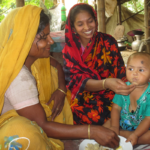The humanitarian response system is struggling to keep pace with the growing demands of more complex crises and the changing nature of conflict.
Humanitarian needs around the globe have risen dramatically over the past decades and today we are arguably witnessing the greatest level of human suffering that the world has experienced in the past 70 years. Although the humanitarian response system is saving more lives, preventing more illness, caring for more wounded, and feeding more people than ever, we are struggling to keep pace with the growing demands of more complex crises and the changing nature of conflict. The Centre for Research on the Epidemiology of Disasters (CRED) estimated that more than
172 million people were affected by armed conflict in 2012. UNHCR estimates that there are
currently 65.6 million forcibly displaced people, of which 22.5 are refugees, who have crossed an international border. Moreover, CRED estimated that from 1994 to 2013,
218 million people on average each year were affected by destructive natural disasters around the world.
The medical journal Lancet published a special series of articles in 2017 to draw attention to the gaps in knowledge for addressing health needs in humanitarian crises. We summarize a few of these articles here and conclude that more implementation science and improved data systems will both be important for filling the knowledge gaps.
Exploring different models of health financing, taking advantage of innovation and technology, and producing better data and research are all elements of improving efficiency, effectiveness, and sustainability.
In one of the
Lancet articles,
Paul Spiegel (2017), based on decades working in the field, including 12 years at the UN Refugee Agency (UNHCR), describes the humanitarian system as “not just broke, but broken”, and he offers some recommendations. One recommendation is to “integrate affected persons into national health care systems.” To do this, Spiegel argues, it will be necessary to address the nexus between humanitarian assistance and long-term development efforts. He gives examples of research and program learning that can help us to strengthen this nexus. Another recommendation is to “make interventions efficient, effective, and sustainable.” Spiegel argues that exploring different models of health financing, taking advantage of innovation and technology, and producing better data and research are all elements of improving efficiency, effectiveness, and sustainability.
Blanchet, et al. (2017), in a systematic review published in the same series, shed light on just how much research on public health interventions in humanitarian crises has been conducted, and they identify several major gaps in evidence. There were relatively more studies of communicable disease control (n = 131), but given the wide range of diseases in this domain, the evidence base remains inadequate. Nutrition interventions have also been widely studied (n = 77), notably on the management of acute malnutrition in young children. There were few studies of non-communicable disease interventions (n = 8) and water, sanitation, and hygiene (n = 6). Encouragingly, at the 2018 annual meeting of the Consortium of Universities for Global Health in New York in March, there was an excellent session on “Chronic Emergency: Strengthening Health Systems to Provide Non-Communicable Disease Services to Refugees and Displaced Populations” that addressed several of the critical challenges to this enormous problem including innovative financing mechanisms that will allow for a sustainable response.
There is a greater need for evidence about interventions, particularly on how to design health responses that are efficient and effective.
Both articles conclude that there is a greater need for evidence about interventions, particularly on how to design health responses that are efficient and effective. We believe the situation calls for a greater use of implementation science. Implementation science produces evidence about interventions to help implementers design context-specific, evidence-based interventions to have broad uptake and maximum impact (see
this post for more information). Because implementation science studies interventions in context, it can help us to identify which interventions with established effectiveness in non-emergency settings are suitable for crisis response and how to adapt them to the realities of the emergency. Successful adaptions of effective responses can lead to prevention of illness and death, and the strengthening of family and community resilience.
Recognizing that timeliness is a crucial component of effective humanitarian action we must at the same time aspire to collect high-quality public health data in these complex operating environments that can be used for both research and response management. Checchi, et al. (2017) in the same series review the methods for collecting public health data in crisis settings. Geographic information systems (GIS) and use of mobile phone-based technologies offer powerful tools for collecting data linked with locations for assessing problems and formulating efficient solutions. One essential application is the estimation of the size of an affected population and the gender and age group breakdown to allow for planning of services. Other key parameters are the public health risk factors (e.g., physical injuries and gender-based violence) and health services facilities on the affected area. These new tools allow for real-time reporting of public health data that can lead to rapid responses.
We need an ongoing process of data collection and evidence generation from each crisis situation to better define what works best in each context and setting.
While we have made progress over the last half century in developing a knowledge base for humanitarian response, we need an ongoing process of data collection and evidence generation from each crisis situation to better define what works best in each context and setting. Implementation science research methods are highly adaptable and can be readily integrated into humanitarian responses. Technological innovations can help to increase and improve data collection. The crushing demand for humanitarian assistance requires us to work smarter, more effectively, and more efficiently. The lives of millions are at stake.
Photo credit: Kunle Lawal/FHI 360
Sharing is caring!



